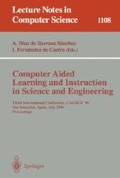Abstract
This paper describes a learning environment in the domain of breast disease and discusses some of the issues in designing a system cooperatively with content, pedagogical, and computer programming experts. The environment uses curricular content, presented in a non-linear fashion, from third and fourth year medical school; all aspects of the curriculum are available simultaneously to enhance the integration of declarative and procedural knowledge necessary in skilled clinical performance. The system represents an interactive, authentic environment where learners construct knowledge, develop higher order cognitive skills such as diagnosis, reasoning, and decision making, apply knowledge and skills, interact with patients, and receive appropriate feedback. The design of the learning environment is based on the theory of cognitive apprenticeship, thus the type and level of information and feedback provided by the system is dependent up on the learner's input. The system also allows learners to evaluate themselves by comparing their actions and decisions to those of experts in the field. The collaboration of experts from different disciplines in designing this environment has resulted in a greater degree of sophistication in ways in which the project has been conceptualized and reified. By focusing all experts on the learning goals of the environment and by cooperatively assisting each type of expert to extend their knowledge of the other areas, we have been able to create a system that incorporates the key theoretical principles from each area. The result is a learning environment that emphasizes meaningful learning of knowledge and skills that learners can apply when they are confronted with similar situations in the real world.
Paper submitted to the Third International Conference on Computer Aided Learning and Instruction in Science and Engineering, Donostia — San Sebastian, Spain, July, 1996.
The authors gratefully acknowledge the input and assistance of CAE Electronics Ltd. and Paul Aleong in the preparation of this paper.
Preview
Unable to display preview. Download preview PDF.
References
Bouchard, R. M., Lajoie, S. P., & Fleiszer, D. (1995). Constructing knowledge within the medical domain: A cognitive perspective. In Cox, K., & Marsh, J. (Eds.), Proceedings of the First International Cognitive Technology Conference (pp. 19–37). Hong Kong: City University.
Cognition and technology group at Vanderbilt (1989). Anchored instruction and its relationship to situated cognition. Educational Researcher, 19(6), 2–10.
Collins, A. Brown, J.S., & Duguid, P. (1989). Cognitive apprenticeship: Teaching the craft of reading. In L. Resnick (Ed.) Knowledge, Learning and Instruction: Essays in honor of Robert Glaser. Hillsdale, NJ: Erlbaum
Lajoie, S. P., & Derry, S. J. (Eds.). (1993). Computers as cognitive tools Hillsdale, NJ: Erlbaum.
Lajoie, S. P., & Lesgold, A. (1992). Apprenticeship training in the workplace: A computer-coached practice environment as a new form of apprenticeship. In M. Farr & J. Psotka (Eds.), Intelligent instruction by computer: Theory and practice., (pp. 15–36). NY: Taylor & Francis.
Lesgold, A., Lajoie, S. P., Bunzo, M., & Eggan, G. (1992). SHERLOCK: A coached practice environment for an electronics troubleshooting job. In J. H. Larkin & R. W. Chabay (Eds.), Computer assisted instruction and intelligent tutoring systems: Shared goals and complementary approaches., (pp. 201–238). Hillsdale, NJ: Erlbaum.
Lesgold, A., Lajoie, S. P., Logan, D., & Eggan, G. M. (1990). Cognitive task analysis approaches to testing. In N. Frederiksen, R. Glaser, A. Lesgold, & M. Shafto (Eds.), Diagnostic monitoring of skill and knowledge acquisition., (pp. 325–350). Hillsdale, NJ: Erlbaum.
Means, B. (1993). Cognitive Task Analysis as a basis for instructional design. In M. Rabinowitz (Ed.). Cognitive Science Foundations of Instruction., (pp 97–118). Hillsdale, NJ: Erlbaum.
Sharples, M., duBoulay, B., Teather, B., Teather, D., Jeffrey, N., & duBoulay, G. (1995). The MR Tutor: Computer-based training and professional practice. In J. Greer (Ed.) Proceedings of the 7th World Conference on Artificial Intelligence In Education, Washington, CS., AACE Publishing.
Author information
Authors and Affiliations
Corresponding author
Editor information
Rights and permissions
Copyright information
© 1996 Springer-Verlag Berlin Heidelberg
About this paper
Cite this paper
Rahilly, T.J. et al. (1996). The informed professor: Clinical instruction of breast disease diagnosis and management. In: Díaz de Ilarraza Sánchez, A., Fernández de Castro, I. (eds) Computer Aided Learning and Instruction in Science and Engineering. CALISCE 1996. Lecture Notes in Computer Science, vol 1108. Springer, Berlin, Heidelberg. https://doi.org/10.1007/BFb0022630
Download citation
DOI: https://doi.org/10.1007/BFb0022630
Published:
Publisher Name: Springer, Berlin, Heidelberg
Print ISBN: 978-3-540-61491-3
Online ISBN: 978-3-540-68675-0
eBook Packages: Springer Book Archive

